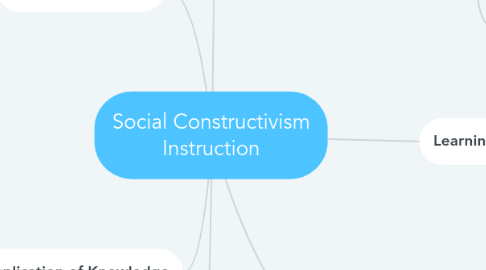
1. Application of Knowledge
1.1. Have students build on prior knowledge
1.1.1. Probe & link prior knowledge through mental organizers, referring to previous activities, etc.
1.2. Have students use their resources
1.2.1. Give access to books, computers, equipment, first-hand experiences, models, etc.
1.3. Let students plan & carry out investigations
1.3.1. Have students debate, create artifacts, and share their findings
1.4. Create opportunities for students to apply concepts & skills to new situations
1.4.1. Let students elaborate on their understandings and form new connections
1.5. Allow students to reflect on what they've discovered
1.5.1. Allow students to discuss, write, and ask questions to deepen understanding and clarify their ideas
2. Active Engagement
2.1. Encourage students to ask questions & make predictions
2.1.1. Let students speak freely & engage in dialogue with their peers
2.2. Let students explore their thinking & make predictions
2.2.1. Let predictions lead to more refined questions and deepened understanding
2.3. Allow students to interact with materials
2.3.1. Incorporate multimodal experiences that appeal to the senses including touch, sight, manipulation, etc.
3. Multiple Representations
3.1. Allow students to show understanding through different mediums like posters, writing, concrete representations, etc.
3.1.1. Posters, 3D models, exam, artifacts, etc.
4. Authentic Tasks
4.1. Use driving questions as focus
4.1.1. These should contextualize learning in the lives of learners, organize concepts, and drive activities
4.2. Make questions and scenarios relevant to students & their lives
4.2.1. Turn them into driving questions by making them meaningful to students and relevant to their lives outside of school
4.3. Utilize technology to connect learning to life outside of school
4.3.1. Use these to serve as cognitive tools (collect data, create graphs, make models, etc.)
4.4. Science concepts and principals should emerge as needed to answer the driving question
4.4.1. Concepts can be more easily integrated into students' understanding by making them applicable to other areas of content
5. Learning Environment
5.1. Create a safe space for students to make inquiries and explore their thinking
5.2. Remain judgement free and give ample time for students to respond to questions, rephrasing when needed
6. Form a Learning Community
6.1. Let students use language as a tool to express their knowledge
6.1.1. Sharing ideas, verbally or written
6.2. Students will express, debate, and come to a resolution regarding ideas, concepts, & theories
6.2.1. Encourage students to explore phenomena and show how student language links to science language
6.3. Students can debate the validity of evidence
6.3.1. Encourage students to question sufficiency of evidence to support claims
6.4. Learning should be situated in a social context
6.4.1. Encourage and allow social interactions to help students build integrated understandings
6.5. Experts and knowledgeable others can help students learn new ideas and skills they couldn't otherwise learn on their own
6.5.1. Allow students to work collaboratively with knowledgeable peers, and utilize the zone of proximal development
6.5.1.1. These knowledgeable others should use scaffolding that includes modeling, coaching, sequencing, reducing complexity, and pointing out critical features
